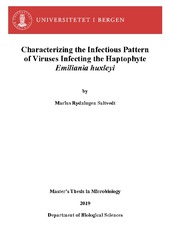Characterizing the Infectious Pattern of Viruses Infecting the Haptophyte Emiliania huxleyi
Master thesis
Permanent lenke
https://hdl.handle.net/1956/20323Utgivelsesdato
2019-06-21Metadata
Vis full innførselSamlinger
- Master theses [267]
Sammendrag
Marine viruses play an important role in biodiversity, population abundance and biogeochemical cycling of elements in the environment. They exhibit a broad range of infectious patterns and it is of ecological interest to gain further knowledge about these complex systems. This study investigated infectious patterns by cross-infecting three strains of the ubiquitous coccolithophore Emiliania huxleyi (CCMP374, CCMP371 and B) with three Emiliania huxleyi virus strains (EhV-99B1, EhV-208 and EhV-86). The infectious- and total virus particles were monitored by most probable number (MPN) and flow cytometry (FCM), respectively. Our results presented variations in both infectious and total virus particle production when the three host strains were infected by virus strain EhV-99B1. The two other virus strains, EhV -208 and -86, were only able to propagate on one host strain (CCMP374), but induced a reduction in growth on the other two host strains (CCMP371 and B). EhV -208 and -86 were in this study defined as specialist viruses, however, they did not present any beneficial traits that exceeded the generalist virus EhV-99B1, suggesting the presence of other traits that allow them to persist. On the other hand, the host strains displayed killing the winner dynamics, but further investigations are necessary. Additionally, this study assessed how the three host strains responded to EhVs sampled during a mesocosm experiment, where an E. huxleyi bloom crashed by viral lysis. The same EhV genotype was observed throughout the bloom and was phylogenetically distinct from EhV -208 and -86, but despite this, presented equivalent infectious pattern. At last, we were able to confirm that the burst sizes diminished with increasing MOI, which ultimately led to the same number of virus particles, regardless of the initial MOI. We proposed viral enhanced extracellular vesicles (EVs), which are actively produced by infected cells, as the causative agent for both the reduced growth in resistant host cultures and the diminishing burst sizes with increasing MOIs.
